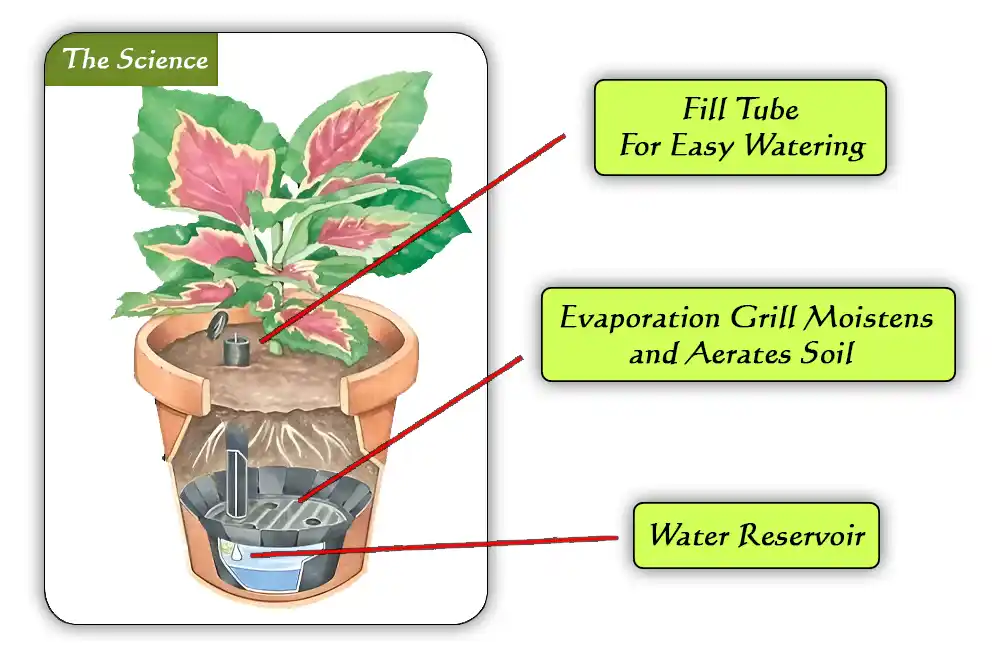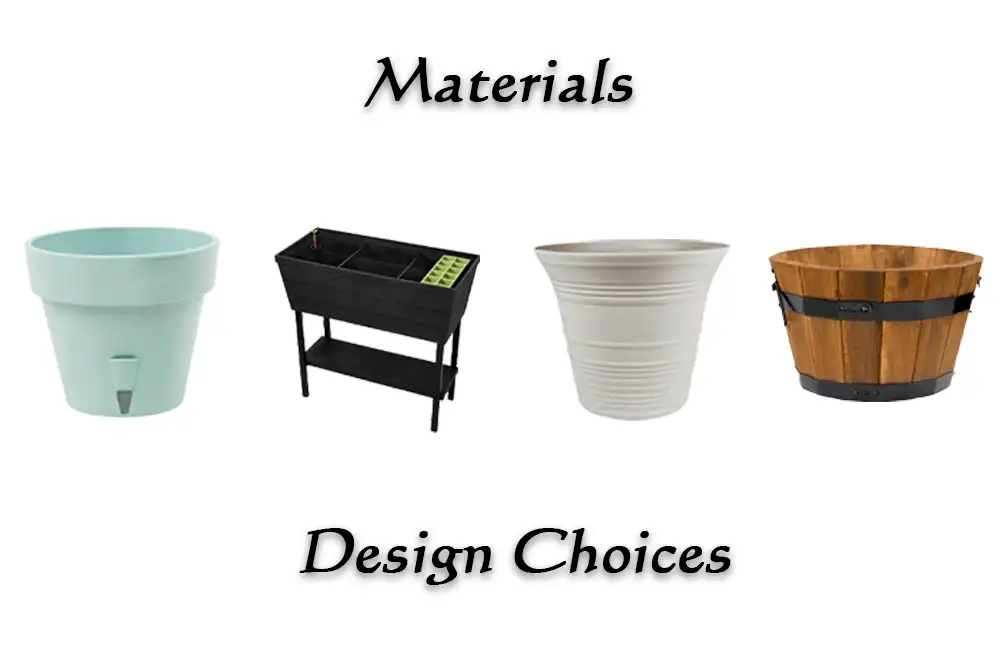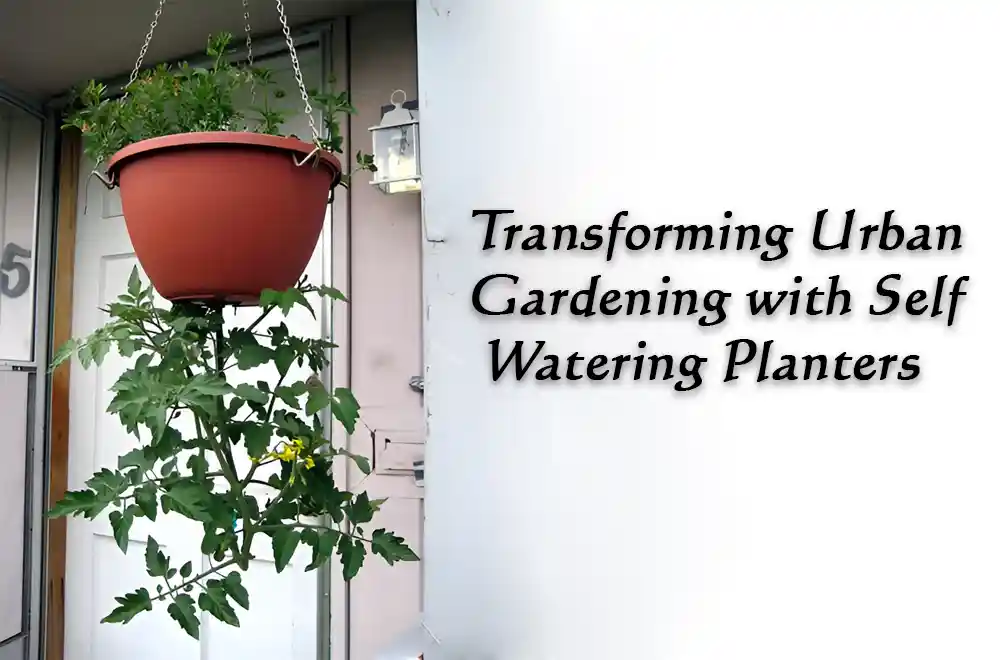Did you know that using self-watering planters can reduce the time you spend on garden maintenance by up to 70%? Imagine coming home after a long day, knowing your plants are perfectly watered without any extra effort from you. It offers a convenient solution for plant care, especially for busy individuals.
As a gardening enthusiast who’s tried countless methods to keep plants thriving, I can tell you, self-watering planters are a game-changer. In this article, we’ll explore How Do Self-Watering Planters Work. You’ll learn how they keep your plants happy and healthy with less work from you.
Table of Contents
How to Make Self Watering Planters

Ever wondered how to keep your plants happy without watering them every day? Self-watering planters are your answer. These clever pots use capillary action and smart design to keep your plants hydrated without constant attention.
The Secret of Self-Watering Planters: At the bottom of these smart pots, there’s a special area that holds water. This means your plants can absorb water whenever they need it, without you having to water them daily. It’s like having a helpful friend take care of your garden.
Capillary Action: There’s a special string that connects the water area to the soil. When your plant gets thirsty, this string acts like a tiny straw. It pulls water up to the plant’s roots. This way, the plant gets the water it needs, just when it needs it.
Water Reservoir: At the bottom of the planter, there’s a water reservoir. It stores water, ready for the plant to use. You fill it up, and it does the rest. This is the key to how self-watering planters work.
Wicking System: Think of the wicking system as a bridge. It helps water cross over from the reservoir to the soil. This way, the water gets right to where the plant can reach it. The wicking system makes sure your plant always has access to water.
Overflow Mechanism: To prevent waterlogging, self-watering planters have an overflow feature. The planter drains away any extra water that accumulates due to rain or overfilling. This ensures the roots don’t sit in too much water, which can cause problems with self-watering pots.
Precise Watering: All these parts work together to make sure your plants get just enough water—not too much, not too little. It takes the guesswork out of watering your plants. You don’t have to worry about how to use a self-watering pot correctly; the planter does it for you.
One summer, I was swamped with work and couldn’t water my plants daily. They began to wilt and I felt awful. Then, I discovered self-watering planters. These planters saved my plants and my sanity. Now, my garden thrives even when I’m busy or away.
With self-watering planters, your plants are well taken care of, even if you’re not around all the time. They’re like having a helpful friend for your plants, making sure they’re happy and healthy, no matter how busy you are. So, why not give these smart planters a try? Your plants will thank you!
Benefits of Using Self Watering Planters

Ah, let’s chat about the wonders of self-watering planters, shall we? Trust me, after years of nurturing my own green babies, I’ve come to appreciate the magic these planters bring to the table.
- Effortless Plant Care: Picture this: You’re juggling a million tasks, but worrying about watering your plants isn’t one of them. With self-watering planters, it’s like having a trusty sidekick that takes care of your plants while you tackle life’s other adventures.
- Transforming Your Space: Imagine coming home to a lush paradise, where your plants are thriving and vibrant. That’s the beauty of self-watering planters—they turn your space into a green haven, where you can escape the hustle and bustle of everyday life.
- Low-Maintenance: Let’s face it, not everyone has the time or energy to devote to high-maintenance plants. But with self-watering planters, it’s like having a pet that practically takes care of itself. No feeding or constant attention required—just sit back and watch your plants flourish.
- Beginner-Friendly: Are you new to the world of gardening? Don’t worry, we’ve all been there. Self-watering planters are perfect for beginners, taking the guesswork out of watering and giving you the confidence to grow your green thumb.
- Water Efficiency: These planters are like the eco-warriors of the gardening world. They deliver water directly to the roots, reducing waste and ensuring your plants get just the right amount of hydration. It’s like they have a built-in water-saving feature!
So, whether you’re a seasoned gardener looking to simplify your routine or a newbie eager to dip your toes into the world of gardening, self-watering planters are the way to go. They’re like a breath of fresh air for your plants—and for you too!
Related Post: Unique Tips in Selecting the Best Pot for Monstera
Types of Self Watering Planters

Self Watering Planters are versatile, fitting many plants and spaces:
Variety of Sizes
- Small planters are great for herbs and flowers. They work well on desks or window sills. I remember placing a small self-watering pot on my desk with some mint. It brightened up my workspace and made my tea breaks special.
- Large planters suit big plants or shrubs, giving roots space and easy water access. When I used a large planter for my indoor ficus, it thrived even in the winter. The constant moisture kept the leaves lush and green.
Design Choices
- Find sleek, modern designs for contemporary spaces. I have a sleek black planter in my living room. It blends in with the decor and keeps my spider plant healthy.
- Traditional styles add a classic look. I chose a traditional ceramic self-watering pot for my patio. It added a rustic charm to my outdoor space.
- Special planters for balconies save space without crowding. My friend swears by her balcony planters. They allow her to grow tomatoes in her tiny apartment with ease.
Materials: Self-watering planters can be made from many materials. Let’s talk about which ones work best and why:
- Plastic: Plastic is light and doesn’t break easily. It’s great for these planters because it keeps water in without leaking. Plus, you can find lots of colors and shapes. I used a plastic self-watering planter for my basil. It was lightweight, durable, and perfect for my sunny kitchen window.
- Recycled Plastic: This is a smart choice for the planet. Planters made from recycled plastic help reduce waste. They work just like new plastic but are better for the Earth. I switched to recycled plastic planters for my herbs. They perform just as well and give me peace of mind.
- Terracotta and Ceramic: These materials are heavier and look beautiful. They are good at keeping plants cool and letting air move through the soil. This helps the roots stay healthy. My terracotta planter with rosemary looks stunning and keeps the plant roots cool in the summer heat.
- Resin: Resin is a type of plastic that looks like stone or wood but is much lighter. It’s strong and can handle being outside in all kinds of weather. My resin planter looks like a stone pot but is so light. It’s weather-resistant and perfect for my outdoor deck.
Each material has its own benefits. Plastic and resin are light and easy to move. Terracotta and ceramic look classic and are good for plant health. And using recycled plastic is great for the environment.
Related Post : 6 Best Pot For Aloe Plant
How to Use Self Watering Planters Effectively

Using self-watering planters is a great way to keep your plants healthy with less effort. Here’s how to set them up and keep them working well:
Setting Up Your Planter
- Fill the Reservoir: Start by adding water to the planter’s bottom section. This is your water reservoir that will keep the soil moist. When I first used a self-watering pot for my basil, I was surprised by how easy it was to fill the reservoir and let the planter do the rest.
- Add Soil: Next, put soil in the planter. Use a potting mix that’s good for holding moisture but also drains well. I found that using a high-quality mix helps prevent any problems with self-watering pots like waterlogging.
- Plant Your Seeds or Plants: Make a small hole in the soil and place your plant or seeds inside. Cover them lightly with more soil. I remember planting mint in my kitchen window in a small self-watering planter. It was so simple, and soon I had fresh mint for my tea.
Initial Watering
After planting, give your plant a good drink from the top. This helps the soil settle and starts the wicking action that pulls water up from the reservoir. When I planted my ficus in a large planter, this initial top watering made sure the soil was evenly moist.
Maintaining Your Planter
- Check the Water Level: Keep an eye on the reservoir’s water level, especially in hot weather. Refill it as needed. I once forgot to refill the reservoir during a hot spell, and my poor plants wilted. Lesson learned!
- Clean the Reservoir: Every now and then, clean out the reservoir to prevent any build-up or blockage. I clean mine every few months to keep everything working smoothly.
- Keep the Wick Efficient: Make sure the wick that brings water to the soil stays clean and clear. This helps water move up to the plant roots easily. A blocked wick can cause issues, so a little maintenance goes a long way.
By following these steps, you’ll have a self-watering planter that makes growing healthy plants easier. Plus, it saves water and time, making gardening more fun and less of a chore. Whether you’re learning how to use self-watering planters or just curious about how self-watering planters work, these tips will help you succeed.
Common Problems and Troubleshooting With Self-Watering Pots

Using self-watering pots can make gardening easier, but they come with their own set of challenges. Here are some common problems you might face and how to solve them:
Root Rot
Do self-watering planters cause root rot? Yes, they can if the soil stays too wet for too long. I had a basil plant that started turning yellow, and when I checked, the roots were mushy from being too wet.
Solution: Use a well-draining soil mix and ensure the reservoir doesn’t stay too full. Let the soil dry out a bit between waterings.
Wick Problems
How do self-watering planters work if the wick isn’t functioning properly? The wick draws water from the reservoir into the soil, but if it gets clogged, your plant might not get enough water. I experienced this with my peace lily; it started wilting even though the reservoir was full.
Solution: Clean or replace the wick regularly to keep it working efficiently.
Algae Growth
Sometimes, algae can grow in the reservoir if it’s exposed to light. I noticed this when my clear plastic planter turned green inside.
Solution: Use opaque planters or cover the reservoir to block light. Clean the reservoir regularly to prevent algae buildup.
Overwatering
How do self-watering pots work to prevent overwatering? They are designed to give plants the right amount of water, but if the reservoir is too large or the soil too compact, it can lead to overwatering. My spider plant suffered from droopy leaves due to this.
Solution: Use the right size planter and a light, airy soil mix. Monitor the water level and adjust as needed.
Underwatering
If the reservoir runs dry, your plants can suffer. I forgot to refill the reservoir during a hot summer, and my tomato plant started to wilt.
Solution: Check the water level often, especially in hot weather. Setting a reminder can help ensure consistent watering.
Soil Compaction
If the soil becomes too compacted, water can’t move up properly. My ficus had this issue, and I had to loosen the soil to fix it.
Solution: Use a soil mix that stays loose and airy. Mix in some perlite or sand to help with this. Regularly check and fluff the soil if needed.
Mineral Buildup
Minerals from tap water can build up in the soil and reservoir, affecting plant health. My herbs started showing signs of nutrient deficiency due to this.
Solution: Use filtered or distilled water to fill the reservoir. Occasionally flush the soil with fresh water to remove excess minerals.
By understanding these common problems with self-watering pots, you can keep your plants thriving. Knowing how self-watering pots work and how to troubleshoot issues makes gardening easier and more enjoyable.
Case Study: Transforming Urban Gardening with Self Watering Planters

Background
Alex lived in a busy city with little space for a garden. He loved plants but struggled to keep his balcony garden alive. His busy life made it hard to stick to a watering schedule, causing his plants to either drown from too much water or wilt from too little.
Implementation
Alex discovered self-watering planters while searching for an easier way to water his plants. These clever pots promised to make watering simple. Excited by the idea, Alex chose different sizes for his small herbs and big vegetable plants. He carefully followed the steps, filling up the water storage area at the bottom and choosing the best soil. This way, he made sure his plants would grow well.
Results
In just a few weeks, Alex saw a big difference. His plants started to thrive. They had brighter leaves and stronger stems. The self-watering planters let his plants take up water whenever they needed it, just like in nature. This helped the plants grow healthier. Plus, it made things easier for Alex.
Water Efficiency
Alex really liked how much water he saved using self-watering planters. These planters hold and use water wisely, meaning not much water is wasted. It was great for Alex because it helped him pay less for water, and it was good for the environment too. This way, Alex saved water, which is good for our planet and his wallet.
Lifestyle Impact
The biggest impact for Alex was on his lifestyle. With the self-watering planters, he didn’t need to worry about watering his plants daily. This freed up his time and reduced the stress of caring for his garden. Now, he could enjoy his garden without the daily hassle, knowing his plants were taking care of themselves.
Verdict
Alex found a great way to garden in the city with self-watering planters. These smart pots are perfect for people with small spaces or busy lives. They water the plants by themselves, saving both time and water. This means your plants always get just the right amount of water to grow strong and healthy. For anyone who wants to make gardening easier and help their plants do well, self-watering planters are a smart choice.
Conclusion
In our blog, we showed how Self Watering Planters make gardening simpler and more enjoyable. These smart pots save water, cut down daily watering, and keep plants happy. Picking a self-watering planter is good for your plants and the planet. Try them out to make your gardening easier and more fun.
So, there you have it! Self-watering planters do the watering for you, like magic! If you’re curious about “How do Self Watering Planters work,” just drop a comment below or contact us for more help. Let’s keep those plants happy and hydrated together!
FAQ
What is a Self Watering Planter?
A self-watering planter has a built-in water reservoir. It gives plants the right amount of water by using a wicking system. This keeps plants healthy with little effort.
How Long Do Self Watering Pots Last?
Self-watering pots can last for many years if you take care of them. They are usually made from durable materials like plastic or ceramic, which helps them stand the test of time.
Do Self Watering Planters Really Work?
Yes, self-watering planters really work. They ensure plants get the right amount of water, reducing the need for frequent watering. This keeps plants healthy and thriving with less effort from you.
What Are the Disadvantages of Self-watering Plants?
Self-watering planters can be expensive. They might cause overwatering if not used right. You also need to clean and check them often to keep them working.
Can All Plants Use Self-watering Planters?
Not all plants thrive in self-watering planters. Plants that like dry soil, like succulents, might not do well. Most other plants, though, benefit from the consistent moisture.
Do Self Watering Planters Cause Root Rot?
Self-watering planters can cause root rot if you overwater. Keep the reservoir small and let soil dry between waterings. Root rot is no fun!

